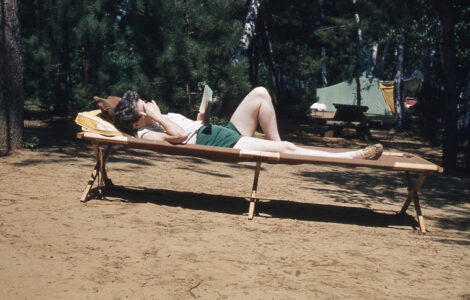It’s a flower! It’s an herb! It’s bee balm

A tiger swallowtail butterfly enjoying a meal of bee balm nectar at a garden in New Russia. (Photo provided)
Red-flowered bee balm (Monarda didyma L) is a long-blooming perennial which is easily grown in any garden soil.
It will achieve heights of 3- to 4-feet or more and, when in full bloom, can be stunningly spectacular in most any landscape or flower garden location.
Mine can be seen growing in a single, absolutely bee-utiful, eye-catching cluster, on a short steep rise along the wooded edge of the yard, amid large rhododendron bushes on one side and a cedar hedgerow on the other. The showy white flowers of queen of the meadow (Filipendula), which grows toward the bottom of the slope, enhance the beauty of the scarlet bee balm blooms, although the queen of the meadow fades long before the bee balm does. Hostas, daylilies, and several other perennial flowers, which grow at the foot of the hill, complete the picture. I’ve also seen attractive, crimson bee balm blossoms, like those that bring my little hillside to life in mid-summer, used delightfully among boulders in a rock garden and very appealingly, as a border planting along an old stone wall.
No matter what the setting, a stand of bee balm can be a welcome, easy-to-grow addition to any flower garden. When in full bloom, a patch of bee balm, with the sun shining brightly upon it, can be absolutely stunning. The blooms are nothing-less-than spectacular and they remain for quite a long time. They’re wonderfully fragrant, too; spicy, sometimes reminding me of citrus, sometimes of oregano.
–
A favorite of pollinators
–
Don’t be frightened or turned off by the name bee balm, which actually refers to its former use in treating bee stings. You won’t have to contend with angry legions of swarming bees in your plantings, although you will often see bees working the aromatic blooms, just as you would see them among plantings of any other sweetly-scented, brilliantly sunlit flowers. The real bonus, as if an ongoing show of such exotic-looking, sweet-smelling blooms isn’t enough, is in the fact that gardeners can also expect their attractive, perfumed plantings to be frequented by nectar-seeking butterflies and hummingbirds, as well.
–
Easy to care for
–
Bee balm is a native mint common to most of eastern North America.
Its roots are creeping rhizomes and, as such, it tends to move outward in all directions, sometimes quite aggressively.
Most gardeners divide their plantings every three years or so, in the spring, to prevent overcrowding. I find it easiest to keep them where I want them by removing plants that are growing along the outermost edges of the planting. The roots are never very deep in the ground, so division and removal is relatively easy. I could plant them elsewhere, but I’ve run out of room. So, I give what I remove away.
Like any plant, once bee balm has finished flowering, it directs all of its energy into producing seed. Deadheading (removing fading flowers) will encourage bee balm plants to produce more blooms, instead. Simply remove any faded flowers by cutting just above the first set of leaves or first set of flower buds beneath the faded flower.
–
Use as a cut flower
–
Bee balm adds beauty, interest and fragrance to indoor arrangements, too. Simply cut the main stem flower just as it begins to open up. The plant’s side shoots will continue to develop and bloom. Side shoots may also be cut for indoor use. Cut flower life is about one week.
–
A brief history
–
Indigenous Americans regarded bee balm as both a medicinal and a culinary herb. The leaves were brewed into teas, which were used to improve digestion and to treat coughs, colds, fever, anxiety, pain and discomfort and melancholy.
In fact, bee balm is sometimes referred to as “Oswego tea,” a name which dates back to the European settlers’ earliest encounters with the Iroquois, or Haudenosaunee people, who were living in the region that now encompasses Oswego and the surrounding areas to the south and southeast of Lake Ontario.
The Shakers, a Christian religious sect that branched off from the Quakers, established a settlement there, and it’s believed that this Shaker community was the first to learn about the uses and value of bee balm, from the native people.
When the American colonists destroyed an entire shipment of English tea by dumping it into Boston harbor, the culmination of a protest against taxes imposed upon them by the British crown with the Tea Act of 1773 — an event which later became known as the Boston Tea Party — the use of Oswego tea became common and popular.
It’s generally accepted that, sometime later, a John Bartram of Philadelphia sent bee balm seeds to England, where growing the highly-aromatic, attractive scarlet flowers became quite fashionable. Oswego tea was soon enjoyed throughout much of Europe, where it was cultivated under the names Gold Melissa and Indian Nettle.
Bee balm is related to the bergamot used in Earl Grey Tea. And Bee balm teas can be used in recipes that call for Earl Grey. The leaves can be dried and used alone or in combination with other herbs to create unique and refreshing herbal tea blends. The blooms can also be used, but sparingly, as they are strongly flavored. Flower heads steeped in liquid can be made into jams and sorbets, as well. I’m told too, that the leaves can be used to really perk up the flavor of homemade apple jelly. And the petals can be used as a spicy garnish for salads and soups.


